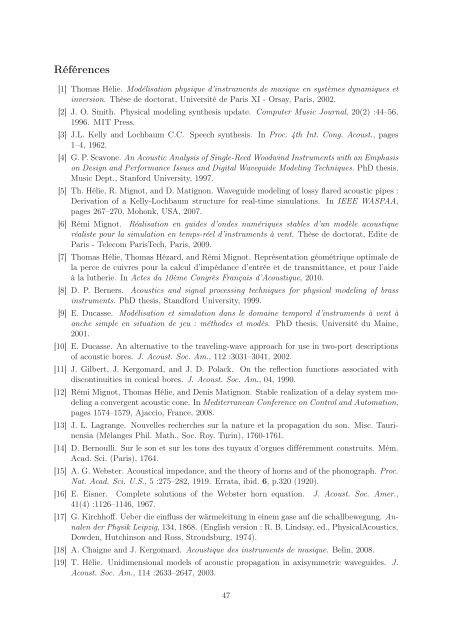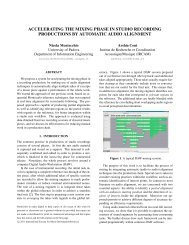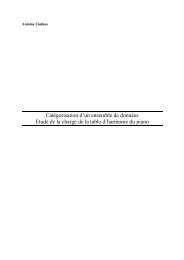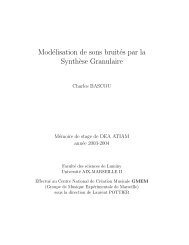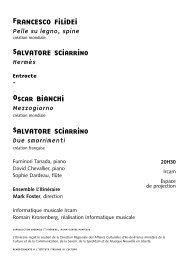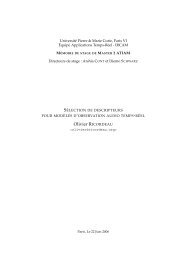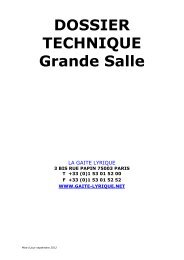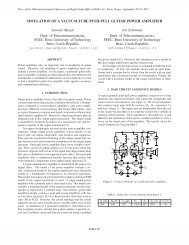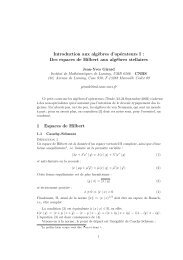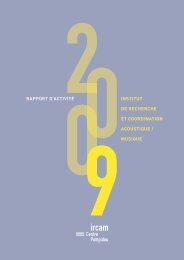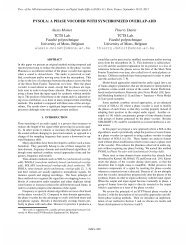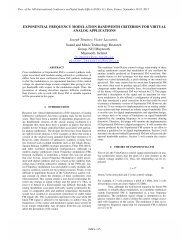Rapport de stage - Master 2 SAR ATIAM - Base des articles ...
Rapport de stage - Master 2 SAR ATIAM - Base des articles ...
Rapport de stage - Master 2 SAR ATIAM - Base des articles ...
- No tags were found...
Create successful ePaper yourself
Turn your PDF publications into a flip-book with our unique Google optimized e-Paper software.
Références[1] Thomas Hélie. Modélisation physique d’instruments <strong>de</strong> musique en systèmes dynamiques etinversion. Thèse <strong>de</strong> doctorat, Université <strong>de</strong> Paris XI - Orsay, Paris, 2002.[2] J. O. Smith. Physical mo<strong>de</strong>ling synthesis update. Computer Music Journal, 20(2) :44–56,1996. MIT Press.[3] J.L. Kelly and Lochbaum C.C. Speech synthesis. In Proc. 4th Int. Cong. Acoust., pages1–4, 1962.[4] G. P. Scavone. An Acoustic Analysis of Single-Reed Woodwind Instruments with an Emphasison Design and Performance Issues and Digital Wavegui<strong>de</strong> Mo<strong>de</strong>ling Techniques. PhD thesis,Music Dept., Stanford University, 1997.[5] Th. Hélie, R. Mignot, and D. Matignon. Wavegui<strong>de</strong> mo<strong>de</strong>ling of lossy flared acoustic pipes :Derivation of a Kelly-Lochbaum structure for real-time simulations. In IEEE WASPAA,pages 267–270, Mohonk, USA, 2007.[6] Rémi Mignot. Réalisation en gui<strong>de</strong>s d’on<strong>de</strong>s numériques stables d’un modèle acoustiqueréaliste pour la simulation en temps-réel d’instruments à vent. Thèse <strong>de</strong> doctorat, Edite <strong>de</strong>Paris - Telecom ParisTech, Paris, 2009.[7] Thomas Hélie, Thomas Hézard, and Rémi Mignot. Représentation géométrique optimale <strong>de</strong>la perce <strong>de</strong> cuivres pour la calcul d’impédance d’entrée et <strong>de</strong> transmittance, et pour l’ai<strong>de</strong>à la lutherie. In Actes du 10ème Congrès Français d’Acoustique, 2010.[8] D. P. Berners. Acoustics and signal processing techniques for physical mo<strong>de</strong>ling of brassinstruments. PhD thesis, Standford University, 1999.[9] E. Ducasse. Modélisation et simulation dans le domaine temporel d’instruments à vent àanche simple en situation <strong>de</strong> jeu : métho<strong>de</strong>s et modès. PhD thesis, Université du Maine,2001.[10] E. Ducasse. An alternative to the traveling-wave approach for use in two-port <strong>de</strong>scriptionsof acoustic bores. J. Acoust. Soc. Am., 112 :3031–3041, 2002.[11] J. Gilbert, J. Kergomard, and J. D. Polack. On the reflection functions associated withdiscontinuities in conical bores. J. Acoust. Soc. Am., 04, 1990.[12] Rémi Mignot, Thomas Hélie, and Denis Matignon. Stable realization of a <strong>de</strong>lay system mo<strong>de</strong>linga convergent acoustic cone. In Mediterranean Conference on Control and Automation,pages 1574–1579, Ajaccio, France, 2008.[13] J. L. Lagrange. Nouvelles recherches sur la nature et la propagation du son. Misc. Taurinensia(Mélanges Phil. Math., Soc. Roy. Turin), 1760-1761.[14] D. Bernoulli. Sur le son et sur les tons <strong>de</strong>s tuyaux d’orgues différemment construits. Mém.Acad. Sci. (Paris), 1764.[15] A. G. Webster. Acoustical impedance, and the theory of horns and of the phonograph. Proc.Nat. Acad. Sci. U.S., 5 :275–282, 1919. Errata, ibid. 6, p.320 (1920).[16] E. Eisner. Complete solutions of the Webster horn equation. J. Acoust. Soc. Amer.,41(4) :1126–1146, 1967.[17] G. Kirchhoff. Ueber die einfluss <strong>de</strong>r wärmeleitung in einem gase auf die schallbewegung. Annalen<strong>de</strong>r Physik Leipzig, 134, 1868. (English version : R. B. Lindsay, ed., PhysicalAcoustics,Dow<strong>de</strong>n, Hutchinson and Ross, Stroudsburg, 1974).[18] A. Chaigne and J. Kergomard. Acoustique <strong>de</strong>s instruments <strong>de</strong> musique. Belin, 2008.[19] T. Hélie. Unidimensional mo<strong>de</strong>ls of acoustic propagation in axisymmetric wavegui<strong>de</strong>s. J.Acoust. Soc. Am., 114 :2633–2647, 2003.47


